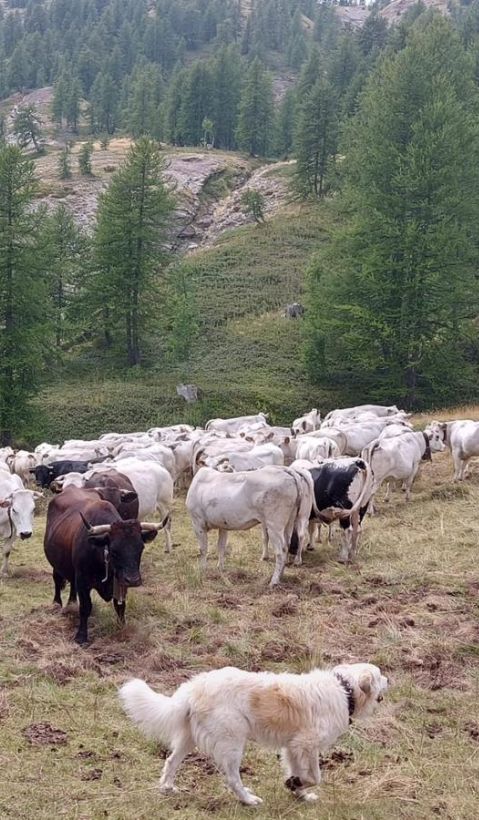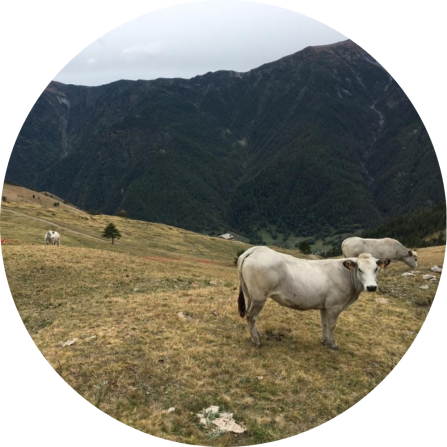

Cattle dominate the livestock sector (444,959 cows in 2023), which benefit from the abundant availability of fodder and Alpine pastures. Sheep and goats play a relatively marginal role (approximately 17,500 goats and 35,300 sheep). The wolf has naturally returned to the area since 1996, and it is estimated that there were at least 35 breeding pairs in 2020/21. Damage to livestock, particularly sheep and goats, caused by wolves is the main challenge associated with their return, making effective damage prevention strategies essential.


Municipalities

Geographical size

Human population

Number of livestock farmers

Livestock farming systems

Large carnivore species

Wolf population
SOCIOECONOMIC CONTEXT
Nestled in the southwestern Italian Alps, this mountainous case study region rises from 920 to 1970 metres above sea level. The landscape is predominantly forested, with open habitats and very few urbanised areas. Part of the region falls within the Maritime Alps Protected Area (Ente di Gestione delle Aree Protette Alpi Marittime), where ecotourism thrives and visitors come to experience the wild alpine environment.
Livestock breeders in Cuneo Province rely on seasonal transhumance to make the most of available grazing – spending summers in the mountains and winters in the Piedmont. This alpine mountain grazing represents an ancient form of pastoralism that contributes to the conservation of the mountain environment whilst producing renowned PDO cheeses.
The Province of Cuneo has a varied alpine environment, dominated by peaks exceeding 3,000 metres and small glaciers, with vast forests of beech, chestnut, and conifer trees, and plant species typical of alpine grasslands. Livestock farming is an integral part of this alpine agricultural landscape, complementing rich wildlife, biodiversity and strong rural traditions. The climate is alpine, with cold, snowy winters, mild summers, and significant seasonal temperature variations. Precipitation varies, but tends to increase with altitude.


FARMING CONTEXT
In Cuneo Province, intensive cattle and sheep and goat farming is practised. Cattle farms, which are used for both meat and milk production, are mainly found in the plains. From June to September, cattle, sheep and goats traditionally migrate to mountain pastures for grazing, with the animals being managed according to their stage of rearing and species.
Alpine farming systems demonstrate a harmonious integration between land use and production, making rational use of local fodder. However, over the last thirty years, the Western Alps have experienced gradual depopulation, and the number of animals raised in valleys and mountain pastures has decreased by almost a third. This has led to reduced grazing land and, with the sharp decline in small permanent farms, a significant increase in average herd and flock sizes.
Main Challenges:
- Declining profitability and dependency on EU subsidies.
- Difficulty in finding workers.
- Depredation by wolves and delayed compensation.
- Scarce rural infrastructure and limited public services.
LOCAL CONFLICT ASSOCIATED WITH LARGE CARNIVORES
Number of attacks:
Wolf attacks on livestock, mostly small livestock, have increased in recent years. In 2023, public veterinary data recorded 460 animals killed or injured in Cuneo Province (72% sheep and goats, 28% cattle) across 248 attacks, concentrated mainly in September during the grazing period. Attacks on cattle, whilst much less frequent than those on sheep, almost doubled in Piedmont Region between 2018 and 2022.
Social conflict:
- Increased workload for farmers implementing prevention measures, and difficulties finding shepherds, especially during summer.
- Difficulties in the management of livestock guarding dog, which sometimes cause problems with tourists.
- Slow and insufficient compensation system.
- Lack of subsidies for purchasing prevention measures and for the maintaining livestock guarding dogs.


Funded by the European Union. Views and opinions expressed are however those of the author(s) only and do not necessarily reflect those of the European Union or the European Research Executive Agency. Neither the European Union nor the granting authority can be held responsible for them.
